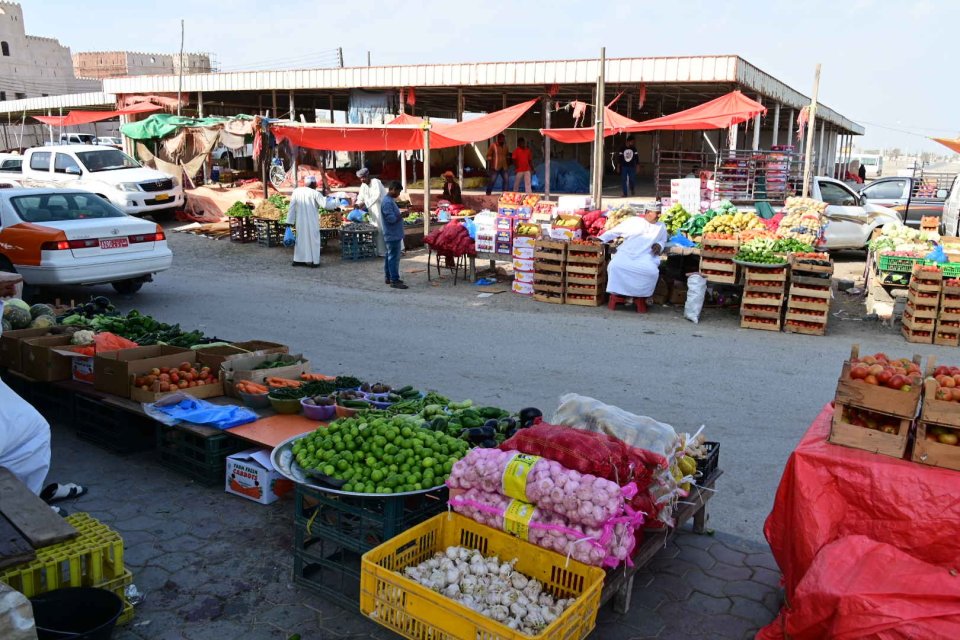Saturday 23 Feb The day had a fairly relaxed start, as the main objective was just to get to our next camp. This was in Barr al Hikman, by the coast, and a good six hours’ drive; so we weren’t expecting to tick large numbers of tourism boxes. But there was interest and scenery in the day even so.
The first thing we did was to go and peer into the local gorge. Near our Jabal Shams camp was a sheer drop

with a view so staggering that it’s impossible to capture on camera.

see what I mean? I tried various video tricks to capture it and I will post any that worked here in due course. But it was a gorgeous view (see what I did there?)
The first stop on our journey was in a town called Bahla, which has a couple of highlights worth seeing. It enabled me to capture a shot of what a typical set of Omani shops looks like.

These are typical of the small, individual booth-type shops that stand by the roadside (there are national brand shop chains, banks etc as well). By decree of the Sultan all shops display a description of their trade or products in English as well as Arabic, which lends a strange familiarity to a very unfamiliar scene! As it happens, these shops were next door to Bahla’s Grand Mosque, which is a striking building.
The main thing that Rashid wanted us to see was the fort, which is being reconstructed, and is a very impressive edifice.
(In front of it is the special local hall for celebrations such as weddings – but for men only. This exercised Jane somewhat, unsurprisingly.)
Rashid also took us to a viewpoint which enabled us to see over the whole of Bahla, showing what a dominant landmark the fort is.
A significant endeavour is the wall which runs right round Bahla. It’s of rudimentary mud brick construction, but stretches right round what you can see above. The authorities have also built a rather imposing gate over the main road into town.
On we motored, and the scenery changed dramatically to reflect the sort of landscape that covers a huge part of Oman – basically desert of various sorts. Plain sand

scrubby vegetation revealing the presence of some water

and mirages of non-existent water; and the ever-present risk of bumping into a camel.
(this means itinerant camels, of course. We also saw another way that you could find camels on the highway:)
This was the scenery that we had for our lunch break.

At about 3.15, we reached Muhut and linked up with the manager of our beach camp, a South African called Devon, who led us on a 50 minute drive over the salt flats to our site – a necessary step, since Rashid didn’t know where the camp was (each camp pretty much gets set up from scratch and the exact location will thus move), and you can get seriously lost when the landscape is nothing but flat sand and scrub. That said, there are markers which those in the know can use, such as this, which shows a fisherman’s track

(my caption for this photo is “The Crate Outdoors”. Thank you. Thank you for listening to my little joke).
Tyres are used to mark junctions.

None of this, however, matches good new-fashioned GPS as a navigation aid, which was what got us to our beachside camp at Barr al-Hikman. This was the same in principle as our mountain camp (majlis, bedroom tent, bathroom tent), but in a very different style:


and it was lovely and warm!
We went for a short stroll along the beach to see what was what. Behind the camp is a lagoon where there were actual flamingoes


There were crabs all over the place

and some mystery plants actually growing in the sand.

The rest of the day panned out pretty much along the lines of our previous, mountain, evenings, only without the shivering – so I was actually able to take a sorely-needed shave.
We ended the day with a splendid dinner on the beach in nice temperatures and with a breeze whose coolness was, for a change, welcome.

And we wound down after dinner shooting the breeze with Devon and making our way further down our supply of gin – a pleasant and relaxed end to a wonderfully relaxed day.
The night passed comfortably enough, but for one noisy distraction – a crab had dug and entered a hole below where our tent was sited, and this wasn’t noticed when the tent was pitched. So the poor thing was scratching to get out for much of the night, but was trapped under the ground sheet. Devon rigged up an escape tunnel in the morning, and it looked like the critter got out OK.


The beach camp is basically 90 minutes by 4×4 from anywhere, so it’s not a base for excursions. Our expectations therefore for Day 4 were of sloth. This turned out to be the case.
Sunday Feb 24 Breakfast was at a relaxed 9am

and we spent the day entirely at leisure. Jane took the occasional stroll to look along the beach, coming across a nice selection of objets trouvés

and I took the opportunity to document the holiday so far (these blogs don’t write themselves, you know). We had a lovely lunch and I tried to capture some photos of local wildlife, with distinctly mixed results. We saw sandpipers

curlews

a heron

and any number of the crabs as they burrowed in for the night (not, thankfully, under our tent this time).
and we whiled away the day in contented relaxation. Tomorrow we have to transfer to the desert, so the story will continue then – tune in again to find out how it went.















































































